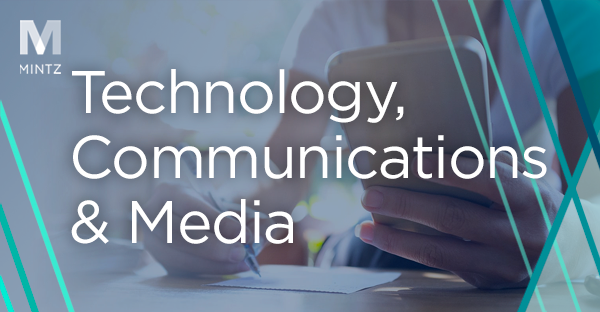What’s New in 5G - May 2022
The next-generation of wireless technologies – known as 5G – is expected to revolutionize business and consumer connectivity, offering network speeds that are up to 100 times faster than 4G LTE, reducing latency to nearly zero, and allowing networks to handle 100 times the number of connected devices, enabling the “Internet of Things.” Leading policymakers – federal regulators and legislators – are making it a top priority to ensure that the wireless industry has the tools it needs to maintain U.S. leadership in commercial 5G deployments. This blog provides monthly updates on FCC actions and Congressional efforts to win the race to 5G.
Regulatory Actions and Initiatives
Spectrum
- The FCC releases a revised inventory of mid-band spectrum in the 2.5 GHz band.
- In preparation for the upcoming auction of licenses in the 2496-2690 MHz band (“2.5 GHz band”), the FCC’s Office of Economics and Analytics (“OEA”) and the Wireless Telecommunications Bureau (“WTB”) released a Public Notice on April 15, 2022, announcing the availability of an updated inventory. The list of licenses, available here, was updated to remove 19 licenses with county/channel block combinations that, in fact, have no unassigned spectrum.
- The FCC facilitates discussions between the federal government and industry to evaluate additional use of the 3.1-3.55 GHz band for commercial services.
- On April 25, 2022, the WTB released a Public Notice exempting from the FCC’s permit-but-disclose requirements ex parte presentations in the 3.1-3.55 GHz proceeding (WT Docket No. 19-348) made to FCC staff in connection with staff’s participation in the National Spectrum Consortium’s Partnering on Advancing Trusted and Holistic Spectrum Solutions (“PATHSS”) Task Group – the industry group tasked with collaborating with the Department of Defense (“DoD”) “to explore sharing solutions to make more mid-band spectrum available for commercial 5G, specifically in 3.1-3.45 GHz.” The Public Notice does not affect ex parte presentations made in connection with other open matters related to the 3.1-3.55 GHz band, specifically: (i) the FCC’s evaluation of the 3.1-3.45 GHz band for commercial use; and (ii) the three petitions for reconsideration that were filed on the rules adopted for the 3.45-3.55 GHz band.
- While industry and DoD will share sensitive information on current and projected military and commercial requirements in the band through the Task Group, the Public Notice adds that if the FCC were to rely on any information in any presentation made through the PATHSS Task Group as part of its consideration of the pending proceedings and/or if the DoD prepares a report based on work in the Task Group, the FCC would place the information in the record and provide an opportunity for public comment.
- The FCC grants additional licenses for mid-band spectrum in the C-band to support 5G services and denies a request by an earth station for incumbent status.
- On April 6, 2022, the WTB announced the grant of two additional applications for eight licenses to operate in the 3.7-3.98 GHz band (“C-band”). A list of the applications, sorted by applicant name, is available here, and a list of the applications, sorted by market, is available here. This grant completes the WTB’s review of applications for licenses in the C-band, the auction for which closed on February 24, 2022.
- On April 13, 2022, the FCC’s International Bureau (“IB”) released a letter denying a request by ARCTEK Satellite Productions (“ARCTEK”) to treat its two temporary-fixed earth stations (“TFEs”) as incumbent earth stations for purposes of the C-band transition. The IB explained that ARCTEK holds two FCC licenses for temporary fixed services in the transmit portion of the C-band (5925-6425 MHz), but it never sought to modify those licenses to provide for use of the receive band (3700-4200 MHz), which would have allowed it to be included as an incumbent earth station and receive costs for relocating from the band. ARCTEK argued that the FCC did not make clear the requirements that TFEs had to take to be considered as part of the C-band transition, but the Bureau disagreed.
Other Regulatory Actions
- NTIA launches the 5G Challenge offering $3 million in prize funding and selects early-bird entries.
- On April 6, 2022, the National Telecommunications and Information Administration (“NTIA”) announced the launch of the 5G Challenge in collaboration with DoD to accelerate the adoption of open interfaces, interoperable components, and multi-vendor solutions toward the development of an open 5G ecosystem. The preliminary event features a total prize purse of up to $3 million to contestants who submit hardware and/or software solutions for one or more of these 5G network subsystems: Distributed Unit (“DU”), Centralized Unit (“CU”), and Radio Unit. The application deadline is May 5, 2022.
- On April 26, 2022, NTIA, in collaboration with DoD, announced that, among the early-bird white paper entries, it selected Rakuten Mobile USA’s CU and DU for interoperability testing with the 5G Challenge host lab, CableLabs.
- The FCC announces the next meeting of the Technological Advisory Council.
- On April 26, 2022, the FCC released a Public Notice announcing that the Technological Advisory Council (“TAC”) – which is comprised of a diverse group of leading technology experts that provide technical expertise to the FCC to identify important areas of innovation and develop informed technology policies supporting the United States’ competitiveness in the global economy – will conduct a meeting at 10:00 am EDT on June 9, 2022. The TAC will consider and advise the FCC on topics such as “6G, artificial intelligence, advanced spectrum sharing technologies, and emerging wireless technologies, including new tools to restore Internet access during shutdowns and other disruptions.”
- In addition, on April 25, 2022, the FCC released a Public Notice announcing that communications between the TAC and FCC staff or Commissioners, including presentations to the TAC and presentations between TAC members and FCC staff or Commissioners, will be treated as “exempt presentations” and are not subject to the restrictions and reporting requirements that would otherwise apply to ex parte presentations. The FCC also announced that it would not rely on any information provided by the TAC in any proceeding unless that information is first placed in the record of the relevant proceeding.
Legislative Efforts
- The House and Senate introduce a bill that would make additional mid-band spectrum available for commercial use, shared federal use, or a combination thereof.
- On April 28, 2022, Representatives Doyle and Latta and Senators Luján and Thune introduced the Spectrum Innovation Act of 2022. The bipartisan, bicameral bill, which is similar to a bill introduced in the House last year, would require the FCC to auction at least 200 megahertz of spectrum in the 3.1-3.45 GHz band for commercial use, shared federal use, or a combination thereof within seven years of enactment. The bill would also permit the President to modify or withdraw any assignment to a federal station in the 3.1-3.45 GHz band after November 30, 2024 in order to make the spectrum available for auction, so long as the modification or withdrawal would not comprise the primary mission of a federal entity operating in the band.
- The House passes a bill that would require the FCC and NTIA to update their Memorandum of Understanding on Spectrum Coordination.
- On April 5, 2022, the House passed the Spectrum Coordination Act. If enacted, the bill would require the FCC and NTIA to revise the Memorandum of Understanding on Spectrum Coordination no later than December 31, 2022 to improve the process for resolving frequency allocation disputes between the two agencies, ensure that spectrum is used efficiently, and establish reasonable timelines for information exchanges between the two agencies. The bill is now in the Senate.

What’s New in 5G - April 2022
April 6, 2022| Blog

What's New in 5G - March 2022
March 3, 2022|

What’s New in 5G - February 2022
February 2, 2022| Blog
Authors
Angela Y. Kung
Member / Chair, Technology, Communications & Media Practice
Angela Y. Kung draws on significant knowledge of the wireless regulatory landscape and experience at the FCC to advise clients on FCC rules and procedures. With particular expertise on spectrum use policies and auction procedures, she has shepherded Mintz's clients through several FCC auctions related to next-generation 5G wireless technologies and routinely advocates on behalf of clients to help ensure that the agency’s rules align with their interests.
Christen B'anca Glenn
Of Counsel
Christen B'anca Glenn is a Mintz attorney who advises communications and technology clients on regulatory and compliance matters before the FCC.


